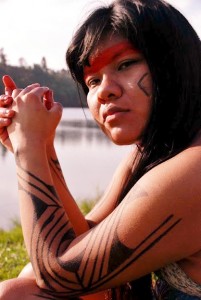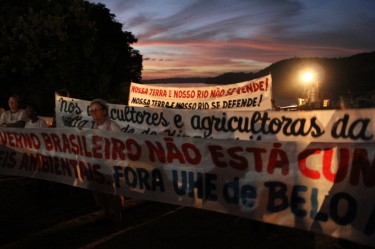This post is part of our special coverage Dossiê Belo Monte (Belo Monte Dossier) [pt] and Indigenous Rights.
[All links lead to Portuguese language pages]
With this interview, divided in two parts, we get to know Sany Kalapalo, a young indigenous activist from Alto Xingu in the Brazilian state Mato Grosso. At only 22 years old, she is one of the coordinators of the mobilization against the controversial Belo Monte hydroelectric powerplant, which is being constructed in the Volta Grande do Xingu region in the state of Pará.
Identified in her blog as a “daughter of Xingu river, from the Kalapalo and Aweti ethnicities, from the Karib dialect,” “indigenous activist,” and “daughter of Pajé Kunue,” Sany is a student about to attempt to enter college in São Paulo and also a teacher of Xingu indigenous culture.
Global Voices (GV): Who is and what does Sany Kalapalo do?

Sany Kalapalo. Image from her personal collection, authorized for publication on this post.
Sany Kalapalo (SK): Sou Sany, indígena do Alto Xingu, no Mato Grosso. Kalapalo por parte da etnia do meu pai e Aweti por parte da etnia da minha mãe, por isso meu nome completo é Sany Aweti Kalapalo, mais conhecida como Sany Kalapalo. Moro na cidade juntamente com uma parte da minha família, e estamos fazendo intercâmbio cultural. Nas férias sempre vamos para o Xingu visitar todos os parentes. Sou estudante e ativista em prol do meio ambiente e povos indígenas.
GV: How did you get involved with the Belo Monte campaign?
SK: Em março de 2011 eu e a minha amiga e parceira de luta Miryám Hess organizamos o primeiro protesto contra a Usina de Belo Monte em São Paulo. Foi um fracasso, só compareceram 12 pessoas, e depois organizamos com muito mais divulgação nas ruas e pela internet, aí conseguimos bom público na maior cidade do Brasil. Também para divulgar mais, quebrei o medo da câmera e fui a algumas TVs online, como JustTV, TV Orkut, e algumas entrevistas nas ruas. Daí por diante participei de vários encontros ambientais, como o Rio+20 também.
GV: Nowadays, is your contact with the Xingu people and monitoring of the plant's construction being made at a distance, or do you have a story of life and presence in the local?
SK: Já faz 9 anos que eu e a minha família moramos aqui [em São Paulo]. Na verdade alguns dos meus irmãos chegaram há pouco tempo, e não ficamos direto na cidade. Nas férias vamos ao Xingu para visitar os parentes e a nossa mãe. Meu contato com o meu povo às vezes é pessoalmente quando eu vou para lá, via telefone, via internet. Sempre tento estar por dentro de tudo que está acontecendo por lá. Tiro informações através das lideranças locais, até porque o Xingu é muito grande, dividido em três partes: Alto Xingu, Médio Xingu e Baixo Xingu.
GV: The mobilization against the hydroelectric took over the streets in some Brazilian cities and generated great buzz over the Internet. In which ways has the use of social networks and virtual tools contributed to enhance the mobilization?
SK: A internet tem sido uma ferramenta superimportante para mobilizar as pessoas, já que as grandes mídias ignoram e manipulam as informações vindas dessa construção Monstruosa!
Por exemplo, em fevereiro de 2011 eu criei minha conta no Facebook voltada para o ativismo contra Belo Monte. Em três meses já estava com cinco mil pessoas na minha página por causa das postagens pesadas e reais que falavam sobre Belo Monte. Muitos que não conheciam a respeito dessa mega Usina passaram a conhecer, e muitos deles se tornaram ativistas em defesa do Xingu. E juntos começamos a fazer grandes manifestações.
SK: The Internet has been a super important tool to mobilize people, seing that big media ignore and manipulate information coming from that monstruous construction!
For instance, in February 2011 I created my Facebook account focused on activism against Belo Monte. In three months, I had 5,000 people on my profile because of the real and heavy posts about Belo Monte. Many of those who didn't know anything about this mega plant got to know, and many of them became activists in favor of the Xingu. And together we started to make great protests.

Protesters against Belo Monte hydroelectric, Altamira. Image by K. L. Hoffmann copyright Demotix (August 19, 2011)
GV: During 2011, you created you Twitter profile (@sanyakalapalo) and a personal blog, and in 2012 a YouTube channel. How do you use and appropriate these pages?
SK: Já estou com Twitter desde o ano passado, só que nunca entrava antes, até porque não sabia mexer direito e agora tô aprendendo aos poucos. rsrs. O blog também criei ano passado e não entro muito nele devido a falta de tempo, já no Facebook entro todos dias. Acredito que as redes sociais ajudam bastante para divulgar qualquer coisa e estão me ajudando muito a divulgar a cultura indígena e a minha luta.
GV: Right on the cover of your blog, you describe yourself as “loved by some, hated by others,” and this intrigues me a little. To what do you refer to in this passage? What affects your reputation?
SK: “Amada por uns, odiada por outros”. É, coloquei assim, porque vejo que tem pessoas que gostam de mim, acompanham meu ativismo, e tem pessoas que se incomodam comigo e me xingam e até hackearam algumas contas que eu tinha nas redes sociais. Às vezes recebo ameaças pelas redes, mas não me incomodo muito com isso e continuo lutando.
GV: You are a young indigenous but very active, and you have inclusively created the Indigenous in Action Movement, that has an page on the internet. Are other young indigenous who have also been using the Internet as a platform of expression and fight?
SK: Faço alguma coisa pelo meu povo e pelo meio ambiente de coração. Escolhi seguir os passos do meu vô, que foi um grande guerreiro xinguano. Ele foi um guerreiro da Paz e tenho muito orgulho de ser neta dele. Criei o Movimento Indígenas em Ação em março de 2011 com o intuito de dizer para todos que índio não é do passado, que ainda existimos e queremos nossos direitos respeitados. Também criei a campanha Orgulho Indígena e recebi alguns prêmios por isso. Atualmente sou presidente-fundadora do Movimento Indígenas em Ação e logo teremos um escritório aqui em São Paulo. Vi que inspirei alguns jovens indígenas. Eles mesmos chegaram e me falaram isso. Acho isso muito bom, cada vez mais jovens indígenas estão participando da política voltada aos nossos direitos.
After starting some university courses, Sany decided to try to enter in the Languages course at Universidade de São Paulo. She intends to be writer to take indigenous culture to other audiences. In a few days we will publish the second part of this interview, in which Sany talks about hydroelectric powerplants, development, indigenous people, and the Internet.
This post is part of our special coverage Dossiê Belo Monte (Belo Monte Dossier) [pt] and Indigenous Rights.







2 comments
Meu País !
( Terra Frima ! Ground Zero ! )